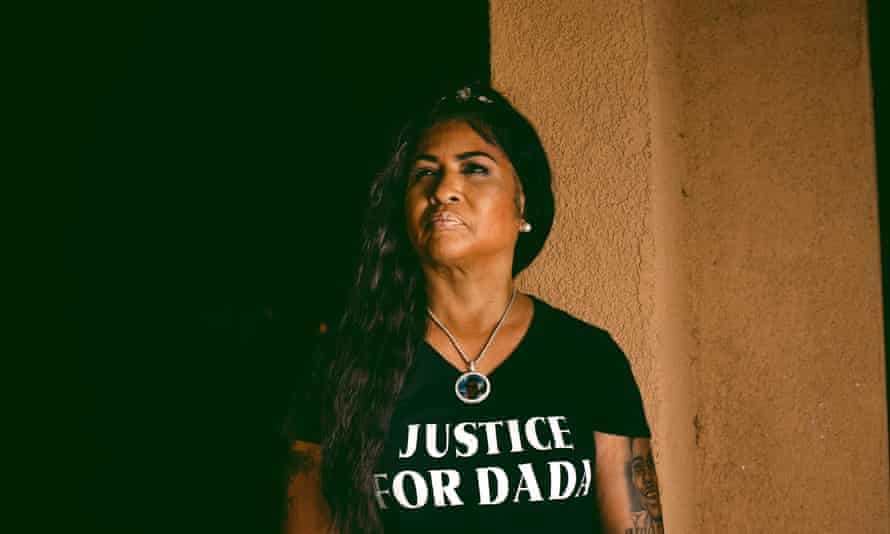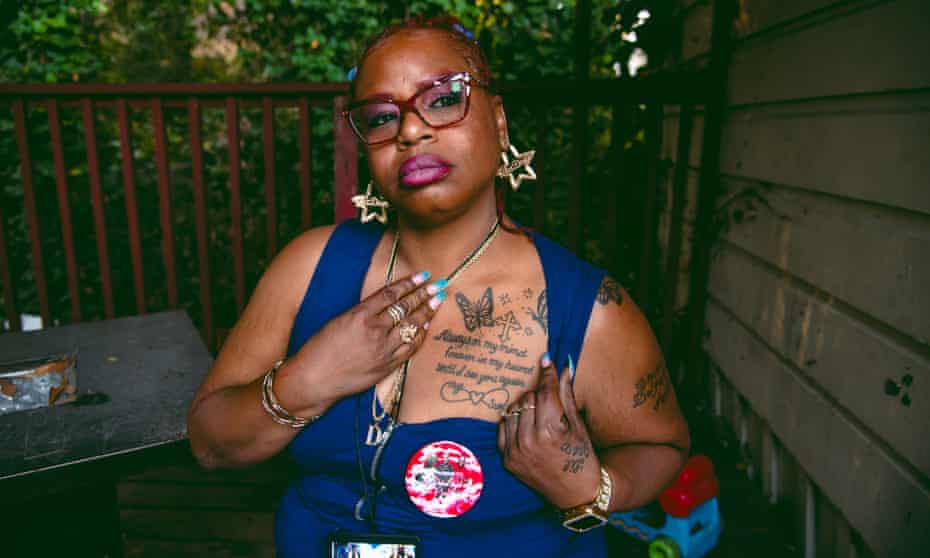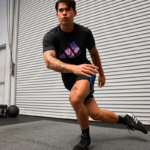
On the night of 3 September 2020, Sonya Mitchell got a call as she was leaving work. Her 23-year-old son, Daimon “Dada” Ferguson, had been shot in a drive-by outside his older sister’s home.
In the months before, Mitchell, 56, had been watching reports of shootings in her hometown of Vallejo, in the San Francisco Bay Area, with increasing concern. There was the shooting at a birthday party on 9 June that killed two women and injured a 10-year-old. Three separate shootings had rocked the city on 20 August, including a double homicide that left a 25-year-old man and his 24-year-old girlfriend dead in a car with their infant son.
Mitchell rushed to the house, expecting a crime scene, police cars and ambulances. Instead she found a group of bystanders, the car the shooters had crashed into the garage of a nearby house, and a man carrying her bleeding son. “What the fuck is going on? Where are the first responders?” Mitchell thought.
Mitchell drove her son to the ambulance entrance of Sutter Solano medical center, but wasn’t let in because he didn’t arrive in an ambulance. She headed to the front of the hospital next, banging on the locked sliding doors.
“He couldn’t even talk at this point, and when I saw the blood I started banging my purse on the door and tried to break the glass,” Mitchell recalled. She pleaded with hospital security officers to help her son, who was bleeding on the pavement. Eventually a security guard came out with a wheelchair to take Ferguson inside. An hour later, a doctor told Mitchell that her son had died. She passed out.

Daimon Ferguson was one of 456 people violently killed across the greater San Francisco Bay Area last year, according to data reported to California’s department of justice.
Like other major cities in the US, the area witnessed a surge in gun violence during the first year of the Covid-19 pandemic. Homicides across the 12 counties that make up the greater region rose 25% in 2020, compared with the previous year, a new Guardian analysis of census data and state homicide data shows. That’s 114 more homicides than the year before.
A detailed analysis shows that homicide rates across the region increased in nine out of 12 counties, but that the rise did not affect all cities and residents equally.
-
The surge was most pronounced in cities that have historically borne the majority of the region’s gun violence, with Vallejo, Oakland and Stockton seeing the biggest rises.
-
The increase hardly touched the Bay Area’s more affluent, suburban areas, where homicide rates barely increased.
-
The overwhelming majority of victims were Black and Latino, with Black residents dying in homicides more than any other racial group.
-
And the surge came after the region witnessed more than a decade of steady declines in gun homicide rates, a decrease that lasted right up until the onset of the pandemic.
Most of the homicides were committed with guns, used not in mass casualty events that make the nightly national news, but in daily shootings on the region’s blocks, streets and in its parks.
Mitchell says that her son was a lifelong mama’s boy who she loved spoiling. He had played football throughout his childhood and adolescence and despite the stereotypes that follow young Black men who are murdered in their communities, her son had love for everyone around him, she said.
“It feels like we’re losing ground,” she said about the rise in shootings in her community. After several more peaceful years, Vallejo families are once again carrying an outsized burden of gun violence in the region. “We’re losing lives daily from Covid and murders and everything else that’s going on.”
More than a data point
The Guardian analyzed three years of homicide data reported by police and sheriff’s departments to the state of California, numbers that do not include police killings or deaths the state classifies as “negligent homicides”.
The analysis shows that most impacted by the surge in homicides in 2020 were three cities that have historically been hit hard by gun violence.
In Oakland, homicides rose from 78 in 2019 to 102 in 2020, the highest single-year increase in the region. The data shows Stockton, where the Bay Area borders the Central Valley, saw 55 homicides in 2020, compared to 35 in 2019. Vallejo, where Sonya Mitchell lives, recorded 27 homicides in 2020, compared to 12 the year before.
Across counties, differences were stark. Alameda county, where Oakland is located, saw 46 more homicides in 2020 than 2019. In Solano county, where Vallejo is, there were 19 more homicides in 2020 than 2019. Stockton’s San Joaquin county counted 32 more people killed than in the year before.
But the surge hardly touched two of the most affluent counties in the Bay Area. Napa and Marin counties recorded just one homicide apiece.
Racial disparities in the burden posed by gun violence were stark. The overwhelming majority of homicide victims in the region in 2020 were Black and Latino, with 194 Black victims among the 450 killed and 150 Latino. Of the 345 Black and Latino victims, 293 were male. Their ages ranged from 1, all the way to 94.
That means that the Bay Area’s Black residents are still more at risk of succumbing to gun violence than members of any other racial group. Black residents make up just 5% of the region’s population, according to 2020 census data, but more than a third of its homicide victims.
The racial discrepancies were apparent even in the region’s safest counties. San Mateo county, home to the millionaire-machine of Silicon Valley, saw homicides go up in 2020, but the rise was not equally distributed. The county of 770,000 people recorded 16 homicides. Just one victim was white, despite most of the county’s residents being white.
Santa Clara county, where Google is based, reported 52 homicides among almost two million residents. At least 32 of the victims, or more than half, were Latino, though Latinos make up 25% of the county’s population.
One of the last victims in the Bay Area in 2020 was 19-year-old André Robinson Jr.André was the 99th homicide victim in Oakland that year, but his mother LaTanya wants him to be remembered as more than a data point. “André was a brother, a son, an uncle and friend to many. He was strong, honest, independent and dependable. He was more than just number 99.”
LaTanya affectionately refers to André Jr as her “Big Sun”, and a dog-loving prankster who was always able to lift her spirits. “He was a special kid and God blessed me with him.”

On the morning of 8 November, André’s girlfriend called LaTanya in hysterics. “André just got shot!” the teen cried into the phone.
LaTanya and her husband rushed to the Oakland home where André had brought his girlfriend breakfast and was shot in the back. LaTanya and her husband, André Robinson Sr, rushed to the home and pulled up at the same time as the ambulance.
LaTanya’s husband briefly saw the couple’s son before he was carried into the ambulance and driven to Oakland’s Highland hospital. As André Jr was being pulled out of the ambulance, LaTanya told her son that she loved him and that she needed him to stay strong and fight. Less than an hour later, when LaTanya and André Sr learned their son had died, it felt like someone “ripped her heart out through the bottom of her stomach”.
Impact of the pandemic
The rise in gun violence in the Bay Area mirrored trends seen across the US. Nationwide, homicides leapt by nearly 30% from 2019 to 2020, according to FBI crime data released in September. About 77% of the killings involved guns and increases were found in every region in the US. California recorded 2,202 homicides, compared to 1,679 the year before – a 31% increase, according to the Guardian’s analysis of state homicide data.
The full dynamics behind the surge in shootings are still unclear, though researchers, violence prevention practitioners and law enforcement have all offered elements, including economic distress, the breakdown of social pillars in the community, and slowdowns in the courts.
California was the first state in the nation to impose shelter-in-place protocols and one of the first to close schools to curb the spread of Covid-19. The fallout from record unemployment to student’s struggles to succeed under remote learning was almost immediately felt by majority Black and Latino communities. Achievement gaps widened as Black and Latino students fell off district radars, giving young people ample time without the supervision and structure that schools provide. Black and Latino people are also simultaneously overrepresented in fields such as food service where job losses were steep and essential sectors such as healthcare and grocery stores where infections and workplace stress were high.
The pandemic further exacerbated issues such as unemployment and housing insecurity that drive gun violence among lower-income Black and Latino residents, factors that added layers of stress onto already fragile communities. Meanwhile, the death of George Floyd reignited anger over police brutality and police killings, further eroding trust in law enforcement in some communities.
“There’s a lot we’re still teasing apart about how gun violence was impacted by the pandemic. But we do know higher rates of poverty, unemployment, police contact, and housing and food insecurity were there before [Covid-19],” said Dr Shani Buggs, a researcher with the Violence Prevention Research program at UC Davis who analyzes grassroots violence interruption. “Then the pandemic severed contacts to social safety nets as these health and social consequences of systemic racism worsened.”
“The communities that were hit worst were the communities that were underserved in the first place,” said Tashante McCoy, a violence prevention and victim advocate in Stockton.
McCoy had formed her own collective for mothers who’d lost their children to gun violence after her cousin was murdered in 2012. Over the years, it grew from seven people meeting for a somber Mother’s Day dinner in 2014 to an organization that came together for paint parties, wine tasting events and meditation sessions that attracted dozens.
The group was one of several gun violence prevention and victim support organizations launching in Stockton around that time. In fact, in the years before the pandemic, the Bay Area had become an incubator for innovative prevention programs.
The programs operated on city streets, in community centers, in urgent care units and public school campuses, often with little to no involvement from law enforcement, and over the past decade they’ve gained acknowledgement from experts and officials in playing an important role in driving homicide numbers to decade-lows.
In Richmond and Stockton, prevention workers with Advance Peace, many of them formerly incarcerated people, worked with the small population of the city that was most at-risk of being shot or shooting someone else and provided mentorship, work opportunities, and stipends. In Oakland, staff with Youth Alive! were showing up at the hospital bedsides of young people suffering from gunshot wounds, offering them resources to change their lives and exit the cycle of violence.
A 2019 Guardian analysis of homicide data in the Bay Area from 2007-2017, found that while homicides and gun violence remained persistent issues, homicides had gone down by 30% across the 12 counties of the region. Black residents, who had historically been overrepresented among homicide victims, experienced the most dramatic drop.

The decrease held in the years leading up to the pandemic. A fresh analysis of homicide data shows that the decline continued in 2018, when the region recorded 309 homicides, and in 2019, when it recorded 336. That increase from 2018 to 2019 pales in comparison to the almost 114 more homicides that would happen in the region in 2020.
“A lot was born in that time,” McCoy said about 2018 and 2019. “There was the inception of a lot of programs, and some of that contributed for sure to a downward trend in gun violence.”
“Everything was down, from shootings to robberies,” recalled Paris Davis, the manager of Youth Alive!’s youth intervention program, who joined the organization after being shot in the stomach in 2017. “That time showed that our approach was working.”
The pandemic presented unprecedented challenges for the organizations’ models. As workplaces, schools, and community centers where violence interrupters were sure to find their program participants emptied, they were forced to switch to virtual meetings and regular phone calls. Many took on additional roles, delivering food, masks and hand sanitizer to homes.
“It had a hard impact professionally. You used to be able to go into the community and mediate. Covid messed with what we were able to do,” said Davis. “We had to start supporting clients virtually. But sometimes it wasn’t best for a client when they needed to see someone in person.”
Stockton’s McCoy said interventionists were still showing up and providing for victims as best as they could. “There’s an unspoken part of being a violence interventionist in a time like this: we can’t not come in there and hug people.” But in doing so, they were sometimes putting their lives on the line.
‘An endless cycle’
The increase in shootings have led to fresh fears about a “violent crime wave”, anxieties that were readily amplified by right-leaning groups and conservative media.
But even with the pandemic surge, homicides across the Bay Area have not reached the highs of the late 1990s and mid-2000s. And many neighborhoods have been minimally impacted.
Still, police unions and tough-on-crime officials, too, have pointed at the rise to argue that efforts to shift away funding from law enforcement agencies was misguided. Others have held it up as an argument for officials to look outside of law enforcement, and scale up community-driven solutions that tackle the root causes of violence.
Responding to the surge, Joe Biden encouraged states and localities to use $350bn from the federal Covid relief package to hire more police. But he also earmarked $5bn in his infrastructure bill proposal to bolster and sustain community-based gun violence prevention, the most high-profile recognition of the importance of such programs in combating gun violence deaths.
“I’m just as sad about this increase as I have been the years before, even when there were just over 70 murders,” said Antoine Towers, chair of Oakland’s Violence Prevention Coalition. “It just shows the endless cycle hasn’t been addressed yet. Those same conflicts were going on before the pandemic.”
Towers had been sounding the alarm about how generational differences and unaddressed trauma among those most impacted by violence, especially youth, was fueling gun violence in Oakland in the years before the pandemic hit. And even when the city was being celebrated for managing to drive down homicide rates, he knew that people were still struggling under the weight of social inequality and long term trauma.
Towers’ organization still isn’t funded through the city but with local schools reopening, he’s being called on by teachers to mediate tense, potentially fatal, conflicts between students. “I get calls from schools, and community members. And I’ll tell them, ‘I’m on my way.’”
McCoy, the Stockton activist, has continued pushing officials and decision makers to prioritize addressing the roots of violence. “This was a public health and safety system failure,” she said. “If we’re ever gonna create safety, you can’t do that without addressing the core needs of the community,” she said. “There’s a lack of investment in these communities and our system fails to fund essential services that are held by people who understand the dynamics of these areas.
‘No one knows this pain but us’
Data from major cities across the US suggests that homicides have continued to rise in 2021, though the increases were smaller than in 2020. .
Since her son’s death, Sonya Mitchell has grown close with other grieving mothers. “The death of my son doesn’t affect just me, it affects so many other Black women who I’ve seen suffer; mothers who are my friends and we all buried our sons in 2020. We have to be there for each other because no one knows this pain but us”.

Her son’s last hours continue to haunt her. “I wish I could have sat on that curb with him, I didn’t know he was gonna die,” she said. “My son deserved to die hearing his mom telling him she loved him. Instead, he died hearing his mom scream for help. I should have never had to beat on a window and scream, ‘Let me in!’”
Sutter Health said in a statement it disagreed with Mitchell’s characterization of events. “Sutter Health extends our deepest sympathies to the family and loved ones of Mr Ferguson,” Sutter Health said. “Our care teams strive to deliver the highest levels of quality care possible.”
Mitchell believes that the high blood pressure and other ailments she’s suffered from since her son’s death will eventually kill her. But she says she doesn’t mind that outcome, if it means she can see her son in heaven.
“I already know where my health is going and I’m not scared,” Mitchell said. “I wanna stay here for my daughters and grandkids, but my heart’s too broken. I used to have hella life, but I just don’t anymore.”
In December 2020, three months after Daimon Ferguson was killed outside of his sister’s home, Vallejo police arrested one man and two women in connection with the slaying.
LaTanya Robinson says she hasn’t had a good day since her son was slain. She’s been trying to move out of Oakland and has become more protective of her 13-year old son. She admits that she rarely lets him out of the house, except to football practice.

The entire family is receiving counseling and Robinson and her husband try to speak about their son and her family’s quest for justice at local rallies. The family is organizing a march in Oakland in November to commemorate André’s death. They still don’t know who killed him.
“I have better days, but never good days. I just lost a piece of me so I’m trying to get back to being me,” Robinson said. “I’ve been trying to speak at rallies and find a way to deal with it. I know my son’s death is gonna bring something positive and I’m gonna get justice one day.”
-
The analysis of California homicide data looks at the year of each incident that caused the death, which can differ from when the victim died or when it was reported to the FBI. In addition, the analysis estimates city-by-city data by looking at the police jurisdiction that reported the homicide


